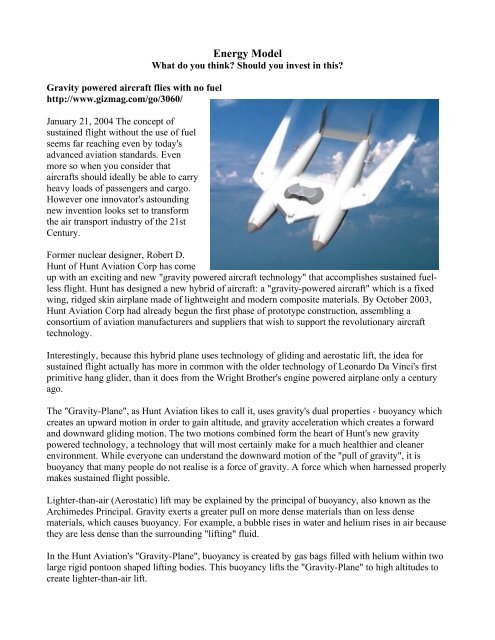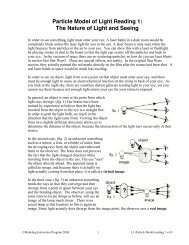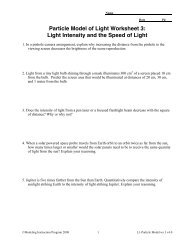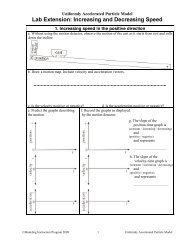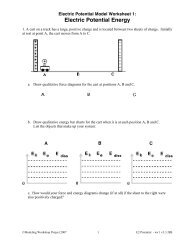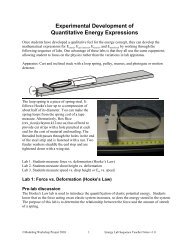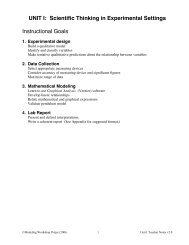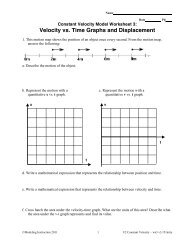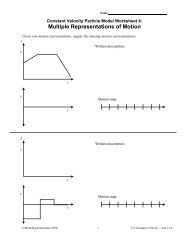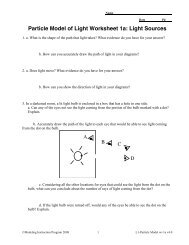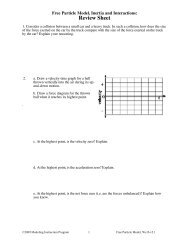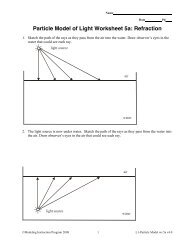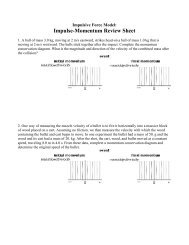You also want an ePaper? Increase the reach of your titles
YUMPU automatically turns print PDFs into web optimized ePapers that Google loves.
Gravity powered aircraft flies with no fuel<br />
http://www.gizmag.com/go/3060/<br />
January 21, 2004 The concept of<br />
sustained flight without the use of fuel<br />
seems far reaching even by today's<br />
advanced aviation standards. Even<br />
more so when you consider that<br />
aircrafts should ideally be able to carry<br />
heavy loads of passengers and cargo.<br />
However one innovator's astounding<br />
new invention looks set to transform<br />
the air transport industry of the 21st<br />
Century.<br />
Energy Model<br />
What do you think Should you invest in this<br />
Former nuclear designer, Robert D.<br />
Hunt of Hunt Aviation Corp has come<br />
up with an exciting and new "gravity powered aircraft technology" that accomplishes sustained fuelless<br />
flight. Hunt has designed a new hybrid of aircraft: a "gravity-powered aircraft" which is a fixed<br />
wing, ridged skin <strong>airplane</strong> made of lightweight and modern composite materials. By October 2003,<br />
Hunt Aviation Corp had already begun the first phase of prototype construction, assembling a<br />
consortium of aviation manufacturers and suppliers that wish to support the revolutionary aircraft<br />
technology.<br />
Interestingly, because this hybrid plane uses technology of gliding and aerostatic lift, the idea for<br />
sustained flight actually has more in common with the older technology of Leonardo Da Vinci's first<br />
primitive hang glider, than it does from the Wright Brother's engine powered <strong>airplane</strong> only a century<br />
ago.<br />
The "Gravity-Plane", as Hunt Aviation likes to call it, uses gravity's dual properties - buoyancy which<br />
creates an upward motion in order to gain altitude, and gravity acceleration which creates a forward<br />
and downward gliding motion. The two motions combined form the heart of Hunt's new gravity<br />
powered technology, a technology that will most certainly make for a much healthier and cleaner<br />
environment. While everyone can understand the downward motion of the "pull of gravity", it is<br />
buoyancy that many people do not realise is a force of gravity. A force which when harnessed properly<br />
makes sustained flight possible.<br />
Lighter-than-air (Aerostatic) lift may be explained by the principal of buoyancy, also known as the<br />
Archimedes Principal. Gravity exerts a greater pull on more dense materials than on less dense<br />
materials, which causes buoyancy. For example, a bubble rises in water and helium rises in air because<br />
they are less dense than the surrounding "lifting" fluid.<br />
In the Hunt Aviation's "Gravity-Plane", buoyancy is created by gas bags filled with helium within two<br />
large rigid pontoon shaped lifting bodies. This buoyancy lifts the "Gravity-Plane" to high altitudes to<br />
create lighter-than-air lift.
Despite it being a better lifting gas than Helium, Hydrogen is generally not used as a lifting gas any<br />
more because it is explosive and combustible. Inert Helium, widely used in lighter-than-air airships,<br />
can now being used to attain altitudes of over 100,000 feet and may be built very large to carry heavy<br />
loads of passengers and cargo approaching 1,000 tons. By comparison, a U. S. military C-17 heavy<br />
lifter only carries near 70 tons.<br />
Even better than Helium, is the idea to use a vacuum-lift system in the hybrid aircraft. During normal<br />
operation of the aircraft, lift is provided by the vacuum contained within rigid cells. As a precautionary<br />
measure, the new hybrid aircraft will use a Dual-Aerostatic-Lift system that will include the use of<br />
vacuum-lift and the use of a lifting gas. The lifting gas is expanded into collapsible gas bags, in the<br />
event of rupture of the vacuum-lift cell wall.<br />
Obvious benefits of the technology are that the aircraft does not require fuel, which is aviation's main<br />
cost. This also makes the aircraft safer in terms of fuel burning or exploding. Furthermore, having no<br />
waste emissions or noise, the aircraft is extremely environmentally friendly. "Hunt's invention is the<br />
first practical use of gravity to provide a motive force by forming a continuous cycle out of two forces<br />
of gravity with the result being, for the first time ever, self-sustained fuel-less flight and this is a<br />
tremendous and historic accomplishment", stated Gene Cox, President of Hunt Aviation Corp.<br />
The Wright Brothers are widely known as the pioneers of powered flight, by making a successful flight<br />
in the first engined <strong>airplane</strong> in 1903. However, one hundred years later in aviation's second century, it<br />
may well be that Robert D. Hunt is seen as modern aviation's next great pioneer of "unpowered" flight.


